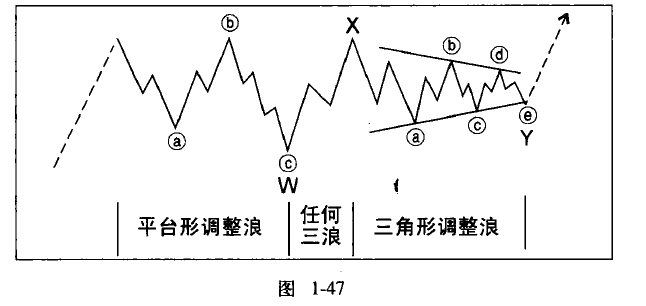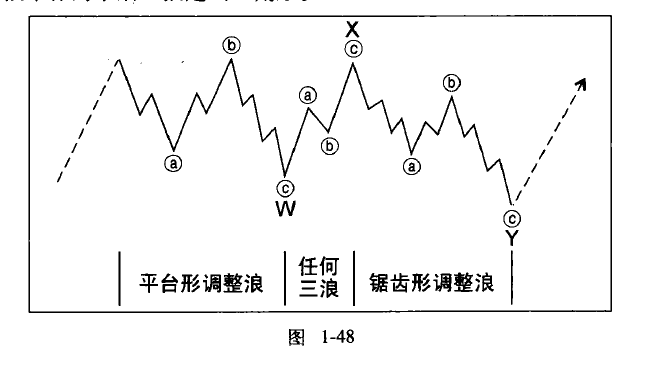In the previous issue, we studied triangular corrective waves; in this issue, we will study combined corrective waves (double three-waves and triple three-waves).
Elliott referred to the horizontal combined corrective pattern of two adjustments as 'triple three-waves' and to the horizontal combination of three adjustments as 'triple three-waves.' Although a three-wave can be any zigzag or platform shape, triangular corrective waves are allowed to be the last component in this combined corrective wave, referred to as 'three-waves' in this combination. Combined corrective waves consist of simpler corrective waves, including zigzags, platform shapes, and triangles. Their appearance resembles an extending horizontal behavior in the form of platform adjustments. The marking method is similar for double zigzag corrective waves and triple zigzag corrective waves, as follows:

Although the illustrative patterns always present examples of two or three parallel platform corrective waves, individual component patterns are more commonly alternating patterns, where a platform shape is followed by an upward triangle, which is a typical type of double three-wave.

A platform formation followed by a zigzag is another example.

Key point: In most cases, the characteristic of combined corrective waves is horizontal. Elliott pointed out that the entire pattern may be inclined in the direction of a larger trend, although we have never observed this situation. One reason is that combined corrective waves have never featured more than one zigzag or more than one triangle. Remember, triangular corrective waves only appear before the last movement of a larger trend, thus acting as the last wave emerging from the triangle in double three-waves or triple three-waves.
So what is the difference between double zigzag, triple zigzag corrective waves, and combined corrective waves?
The trend angle of double zigzag and triple zigzag corrective waves is steep for the horizontal trend of combined corrective waves, but can still be qualitatively classified as non-horizontal combined corrective waves. However, in terms of both adjustment angle and adjustment purpose, double three-waves and triple three-waves are completely different from double zigzag corrective waves and triple zigzag corrective waves. In double zigzag corrective waves or triple zigzag corrective waves, the first zigzag corrective wave is rarely large enough to create sufficient price adjustment for the previous waves. The initial form of double or triple is usually necessary to generate a price retracement of sufficient scale. However, in combined corrective waves, the first simple pattern usually produces adequate price adjustment. The double or triple adjustment pattern is primarily aimed at extending the duration of the adjustment process after the price target is essentially reached. Sometimes, additional time is needed to reach the price channel line or to achieve a closer connection between the driving wave and other corrective waves, that is, to reach price targets and time targets. With the continuation of consolidation, the psychology and fundamentals of participants also extend accordingly with their trend.
Note that the corrective wave consists of a total of 5 waves; if there are extended waves, there will be a total of 9 or 13 waves, and so on (5+4+4+4——). Adjust the waves to 3, and if there are combined corrective waves, there will be a total of 7 or 11 (3+4+4); triangular corrective waves are an exception, although they can be counted as 15 waves. The main exceptions are two types of inclined triangles (wedges), which are hybrids of driving forces and corrective forces.